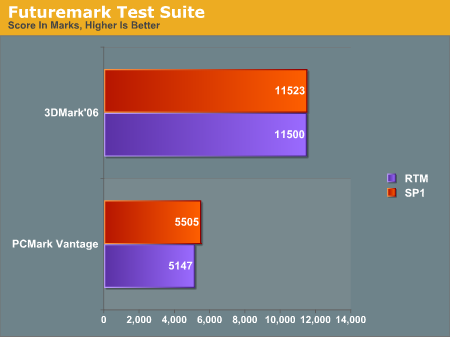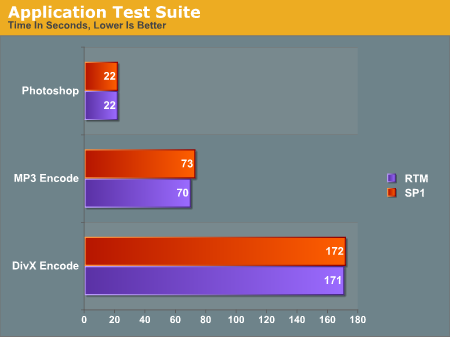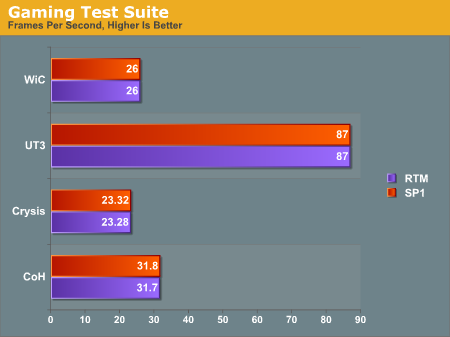Vista vs. Vista SP1
We’ll start with our Futuremark benchmark applications, 3DMark 2006 and PCMark Vantage. 3DMark in spite of being a graphics benchmark is sensitive enough to pick up on any changes in CPU or GPU performance (in this case any optimizations that reduce overhead), while PCMark Vantage is a full suite of benchmarks to measure overall system performance. It’s also one of the few benchmarks that we’re using that has a 64-bit mode.

Starting with 3DMark, the change in performance is effective imperceptible at 0.2%, well within experimental variance. This just goes to show there haven’t been any changes in overhead. PCMark however is far more interesting; here we get a full 7% score increase, indicating that SP1’s effects are felt outside of our earlier benchmarks. Drilling down ino PCMark’s subscores, we found that the higher score is a result of improvements in data compression scores, data encryption scores, and searching in Windows Mail, all of which can be attributed to improvements in file I/O performance. All other subscores are virtually unchanged.
Moving on to our application specific benchmarks, we have our DivX encoding test, our iTunes/LAME MP3 encoding test, and the Retouch Artists speed test for Photoshop. DivX stresses I/O somewhat, while the rest of the tests are largely memory and CPU-bound.

Here we see no notable changes in performance moving to SP1. All of the application tests come back with virtually identical scores.
Finally we have our gaming tests. Games tend to be good
a great way to stress all the components in a system, so this should give us a better idea
of how far improvements in Vista’s file I/O system stretch. For our games we have the RTSes World in Conflict and Company of Heroes, and the FPSes Crysis and Unreal Tournament 3.

In spite of the more rounded nature of gaming tests compared to our application tests, the results are the same with no perceivable improvement in performance. At this point it’s clear that what performance improvements Vista does offer are limited to a handful of situations where we are specifically file or network I/O bound. What this means for any given application is that it is unlikely to see a performance improvement due to SP1.
We also ran some quick testing with startup and shutdown times to see if Vista improved performance there at all; there were a couple of hotfixes in SP1 that dealt with these matters.
| Vista Startup/Shutdown Performance | ||
| |
Pre-SP1
|
Post-SP1
|
| Startup Time |
33 Seconds
|
28 Seconds
|
| Shtudown Time |
32 Seconds
|
31 Seconds
|
| . | ||
While shutdown time doesn’t see any real performance improvements, we are surprised to see an improvement in startup time by several seconds. Vista is not notably slow to start up in the first place, so we weren’t expecting much improvement if there was to be any at all. Shaving off 5 seconds for a 14% improvement in startup time (getting startup below 30 seconds altogether) is a pleasant surprise.










62 Comments
View All Comments
7Enigma - Thursday, February 28, 2008 - link
It's probably to prevent all the tech calls saying, "Gee golly, I have 4 Giga-bites of RAM, but the screen only says I have 3! Where'd the other one go!".I don't see a problem with doing this, as if you care enough to know how much is actually addressable you probably already know the rest of the story anyway.
sprockkets - Thursday, February 28, 2008 - link
Any word if you can use a non sp1 key with a sp1 disk?Most of us hate vista for some reasons, like it for others. It just happens to be that the reasons why we hate it are more than why we like it, such as the way you have to pick how audio is sent to outputs (i.e. analog or digital, but not both at the same time as in previous versions, also that darn cdrom audio input I need), UAC, the fact that after your initial install of Vista that those 80 updates will then cause it upon shutdown to process, then upon restart will spend even more time processing the updates (albeit it only happens once and sp1 will do it for you, for now that is), and of course, everyone's favorite, why the hell did they have to change things like how to remove programs?
Did SP1 restore the cdrom audio input? Probably not. No, I use it for my TV tuner card which Microsoft feels I no longer need to use, which I can still buy.
And for UEFI, perhaps now we can take control of features that should be in the BIOS, yeah, right (I'm looking at you Intel for not putting in S3 standby support on your D201GLY v1 and 2 boards!).
7Enigma - Thursday, February 28, 2008 - link
Many people use nLite or other programs to slipstream a service pack (among other programs and hotfixes). You can then burn this as a new .iso cd and use that in place of your original disk. Short story:I have a 3 year old system that I never reformatted (I know, the shame). When I built the system SP2 had just come out so my XP disk already has sp2 included. But obviously in 3 years quite a few (100's?) updates and hotfixes have come about and it would be a real pain to reformat and then have to go through all the reboots and installs. Not to mention the chance that during this my system could become compromised from a previous exploit.
So I started hearing about "slipstreaming" and spent some time reading about it. These programs basically create a custom installation disk with exactly what you want (and excluding what you don't want), so that you can reformat the drive, install the slipstreamed version of XP or Vista, and have only a handful of updates (I think I had 8 updates total, and required 2 reboots). This is a fantastic way to start from scratch without spending a lot of time.
RyanVM (at least for XP) keeps an infrequent update pack that I used with my SP2 disk to enable the reformat I described above. Once SP3 for XP comes out you could slipstream it to your existing disk in 20min and be ready to reinstall. Really I'll never go back to the old-fashioned way of hosing a system.
HTH (and I apologize if you already knew this)
kdog03 - Wednesday, February 27, 2008 - link
Well?Ryan Smith - Thursday, February 28, 2008 - link
No. That's a fundamental limit of 32bit operation, it can't be fixed.mcnabney - Wednesday, February 27, 2008 - link
In regard to the network throttling to make room for audio. A gigabit connection will be trimmed back to 80Mbs, 8% of capacity. Anandtech writes:"We’ll fully admit the problem will only affect a small number of users (those with gigabit networks who need high network performance while using multimedia applications), but then we’re exactly that kind of user."
Hmmm. Lets think. What might need more than 80Mps while using audio? Hmmmm. How about, playing HD video off of a local media server?
HaZaRd2K6 - Wednesday, February 27, 2008 - link
I just recently bought an eSATA enclosure for backups (FAST!) and in the article you mention "The only significant loser here are file operations over high-latency high-bandwidth links". Would eSATA be included in this list? Any chance of some numbers to check eSATA performance?trparky - Sunday, March 2, 2008 - link
The only difference between eSATA and SATA is the connector. Everything else is the same, even the data encoding used to transmit it across the wire.ellis - Wednesday, February 27, 2008 - link
Does anybody know of any good benchmarks made measuring the multitasking performance on Vista? (vs. XP?)And I'm not talking about the ability for multi-core optimized applications ability to distribute it's load on several cores, but on the ability to run several demanding single threaded applications in parallell nicely distributed on the avalable cores.
So does anyone know of any test that has focused on this aspect of utilizing a multi-core CPUs?
Perhaps comparing dual-core with quad-core, on XP and Vista?
Griswold - Wednesday, February 27, 2008 - link
I cant think of a single benchmark for this other than the "benchmark suite" they use here at AT sometimes (bunch of apps doing certain things creating alot of load and timing it). But I wouldnt really need that as vista always felt more responsive with multiple heavy load tasks than XP - and it even does so on this almost 1 year old install.I would like to expect MS being able to improve on the far from perfect task scheduler that comes with XP for their new flagship OS. As far as i'm concerned, they succeeded.